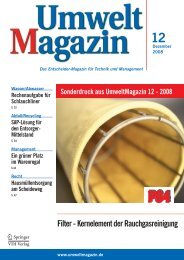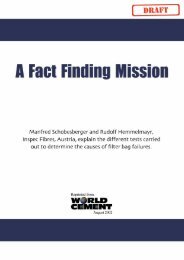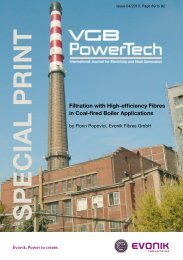PDF (1.43 MB) - P84.com
PDF (1.43 MB) - P84.com
PDF (1.43 MB) - P84.com
Create successful ePaper yourself
Turn your PDF publications into a flip-book with our unique Google optimized e-Paper software.
Filter media development<br />
The quality of needle felts is continuously improved.<br />
Even though the commonly used fibre polymers are<br />
well established, their properties have been optimised,<br />
Figure 4. Clean gas dust concentration during test.<br />
Figure 5. P84 needle felt after 29 months’ operation in a clinker<br />
mill filter. (Left: dust and clean gas side, right: felt cross-section.)<br />
The cross-section is entirely free of dust, showing the typical<br />
picture of a surface filter media.<br />
as well as the process of felt production. The tenacity<br />
of modern needle felts is higher, pores are smaller and<br />
more homogenous than that of earlier material qualities.<br />
Fine fibres and microfibres are more commonly used<br />
and contribute to the high filtration efficiency. Emissions<br />
of single digits of mg/m<br />
3 or even less are possible,<br />
depending on the operating conditions. For the tests<br />
in this article, a standard 2.2 dtex P84 needle felt was<br />
chosen.<br />
Filtration efficiency test<br />
The target of this test was to compare the filtration<br />
efficiency of two kiln filter media, a P84 needle felt and<br />
ePTFE membrane laminated to woven glass. As chemical<br />
and thermal ageing was not of interest, a clinker mill filter<br />
was chosen because of better accessibility than a kiln filter.<br />
The P84 needle felt is a standard material with 2.2 dtex<br />
fibres, the membrane on woven glass is from one of the<br />
established suppliers.<br />
Both materials, the P84 needle felt and the ePTFEmembrane<br />
on woven glass were placed alongside<br />
each other in the filter unit (Table 1). The lower air<br />
permeability of the membrane media (initially and at the<br />
end of the test) results in a lower air flow than through<br />
the needle felt. This means that the mechanical burden on<br />
the membrane media was even less than that on the P84<br />
felt.<br />
After 29 months’ operation in the plant, the filter<br />
bags were taken out of the filter and samples undertook<br />
a filtration efficiency test on a test rig according to<br />
VDI 3926. Dust for the test was taken from the clinker<br />
mill filter hopper. Figure 1 shows the particle size<br />
distribution of the cement dust sampled from the hopper.<br />
The dust load was adjusted to 14 g/m<br />
3 , which is the<br />
upper level for stable operation with the test equipment.<br />
The details of the tested material qualities and the test<br />
sequence are listed in Table 2.<br />
Air permeability<br />
The test started with an air permeability measurement<br />
and several cleaning pulses to determine to which degree<br />
the air permeability recovers. Both media started at<br />
a comparable value; gentle dismounting left a certain<br />
dust cake on the surface. Whereas the P84 needle felt<br />
exhibited good recovery of the air permeability after one<br />
cleaning pulse, the membrane material showed the typical<br />
higher pressure drop of membrane media, even after five<br />
cleaning pulses (Figure 2).<br />
Cleaning frequency/pressure drop<br />
Figure 3 shows the pressure drop development of both<br />
filter media during the test. The membrane material<br />
needs approximately 10 – 15% more frequent cleaning<br />
than the needle felt. In case of similar cleaning frequency,<br />
the P84 needle felt exhibits a 1 mbar lower pressure drop,<br />
which is an advantage of 10%.<br />
Figure 6. Membrane laminated onto woven glass after 29 months’<br />
operation in a clinker mill filter. (Left: clean gas side, right: cracks<br />
in the membrane and cross-section.) Surface filtration is achieved<br />
as long as the integrity of the surface is maintained.<br />
Clean gas dust content<br />
Under test conditions, significantly lower emissions<br />
of the P84 needle felt could be observed (Figure 4).<br />
The operating time of 29 months can be considered to<br />
represent approximately half of the bag life of a kiln filter<br />
media.<br />
Re-printed from [Jun 11]<br />
worldcement.com






